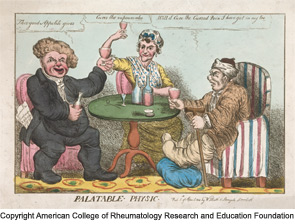
Gout is a common rheumatic disease often characterized by swelling, redness, and intense pain in the big toe. Once thought to be an exclusive disease of the wealthy who overindulged in food and spirits, gout has become a royal pain for millions of Americans.
Last year, Arthritis & Rheumatism reported that the prevalence of gout has swelled in the last two decades.1 The study noted that high blood pressure and obesity may be contributing factors to the rise of gout.
According to the author of the ACR’s patient fact sheet on gout, H. Ralph Schumacher, MD, “Gout often is associated with hypertension and heart and kidney disease, or the use of medications that increase uric acid levels.” Dr. Schumacher also writes, “Lifestyle changes may make it easier to manage this lifetime disease. Suggestions include gradual weight loss, avoidance of alcohol, and reduced consumption of fructose-containing beverages and foods high in purines.”
The treatment of gout can be complicated by coexisting medical conditions and other medications. Dr. Schumacher encourages any person who thinks he or she may have gout to see a rheumatologist and writes, “As experts in the treatment of arthritis, rheumatologists evaluate patients to determine whether gout is the cause of their arthritis, educate them about the role and proper use of medications as well as other treatment measures, and act as a resource to primary-care physicians.”
Rheumatology health professionals can help patients learn more about gout and other rheumatic diseases, medications, and topics by providing access to ACR Patient Fact Sheets, which can be downloaded by visiting www.rheumatology.org and clicking on “Patient Resources” under Popular Content. See an excerpt from the Patient Fact Sheet on Gout.

